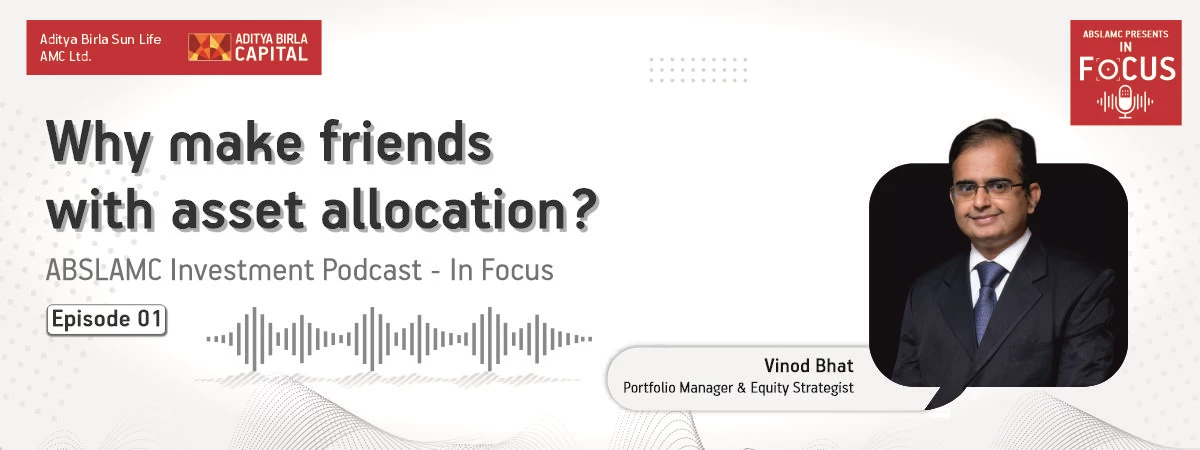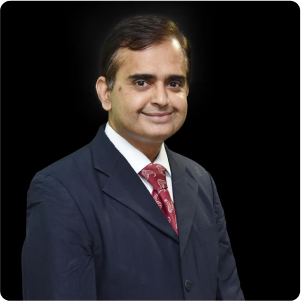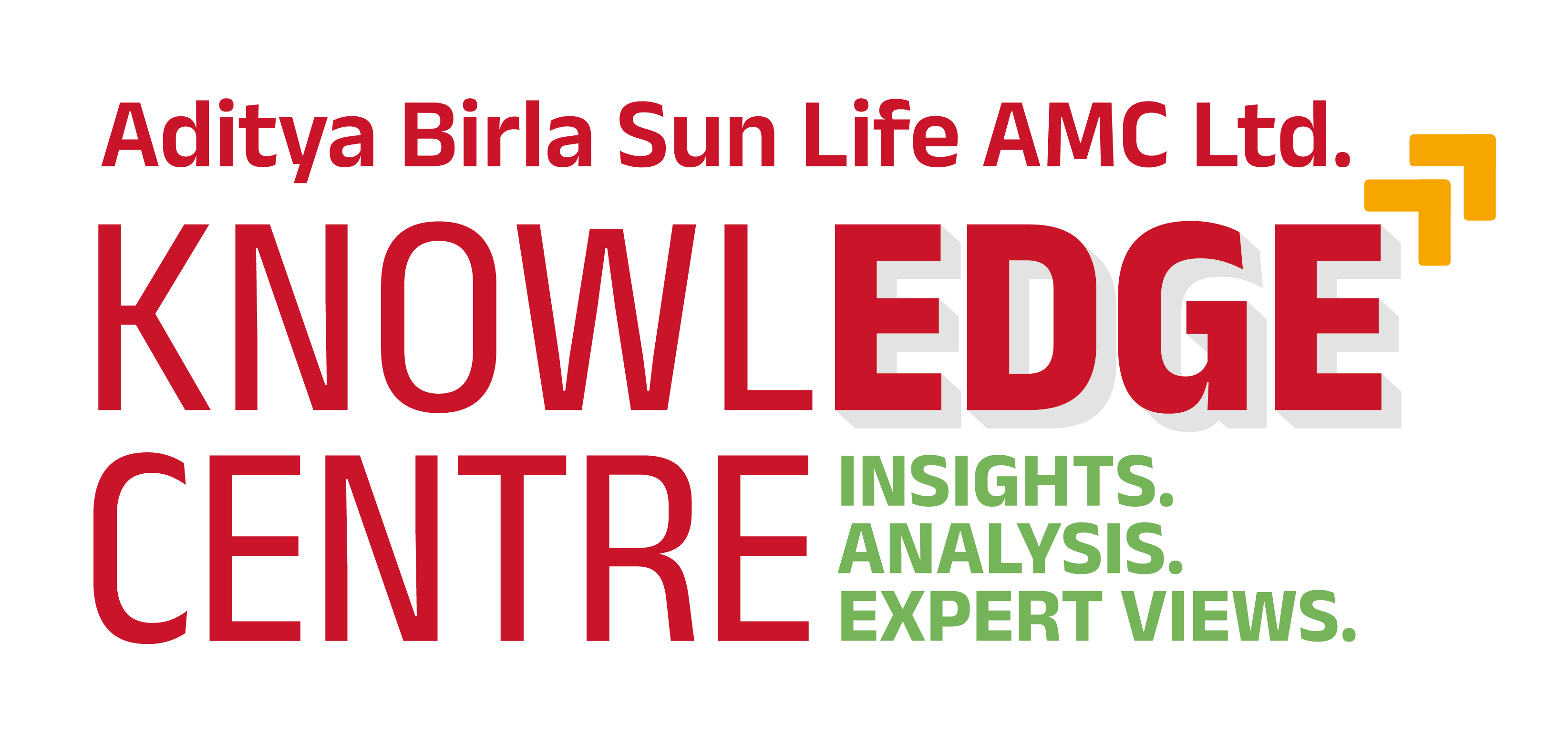-
Our Products
Our FundsFocus Funds
-
Self Care
Self-ServiceFind InformationWays To TransactPartner Solutions
-
Downloads
- Learnings
- About Us
-
More
-
Shareholders
-
Shareholders
-
Updates
-
-
SIP Calculators
- Back
-
Shareholders
Why make friends with asset allocation?

Apr 11, 2023
4.7 Mins Read
 Vinod Bhat
Vinod Bhat
Amrita: Welcome to the podcast Vinod. Vinod I will come to your debut book subsequently, but first as someone who closely follows market trends as a portfolio manager and equity strategist, give us an assessment of the broader market and the macroeconomic backdrop that we are in.
Vinod: Yeah sure Amrita. As we have seen there has been a big rally in equity markets, both globally and in India. So, what is going on?
Investor sentiment has improved, and why is that? It is because if you see in the U.S., the growth numbers have come in above expectations, the inflation numbers are declining, the earnings growth numbers for the quarter have come in again above expectations and we seem to have come to the peak of the monetary policy tightening cycle. So, because of all these positive data points, investor sentiment has improved, and we have seen a rally in the equity markets.
On the other side of the globe, example in China, what has happened is that the recovery has been slower than expected. The foreign institutional investors were looking at alternatives to China, are now looking at for example Japan/Korea/Taiwan and countries like India, and increasingly India is coming out at the top of the list because if you see even in India the data points are quite positive; our growth numbers, our GDP growth numbers have been upgraded, the earnings growth numbers for this quarter are either in line or slightly above expectations. All the high frequency indicators that we track are quite strong and are coming in above expectations. So, overall, in India if you see, the economy seems to be doing quite well, and going forward also we expect that the 3 key drivers of the economy: investments, consumption, exports, all of them should do well.
On the investment side, the government’s focus on capex, infrastructure capex continues, real estate is on an upcycle and we expect the corporate capex cycle also to start going forward. On the consumption side, urban consumption has been doing well. If the monsoons are good, then even the rural consumption should pick up. And on the export side, we had seen a decline in the exports last year but now since the global economy seems to be doing better than expected, even that should see some positive trends going forward.
So going forward we expect that India should be amongst the countries with a good growth compared to the larger economies; that is a general backdrop we are in and hence we have seen the rally in the equity markets.
Amrita: Well, thank you for that overview, Vinod. In that case, in the current scenario, what is the approach that can be taken by an investor as far as their investment portfolios are concerned?
Vinod: Traditionally, what we have seen is that investors get fixated on one or two asset classes. Traditionally in India, as you know, many investors invest in real estate or in gold or keep their money in FDs, some investors have started investing in Equities, through Mutual Funds and in Fixed income. But overall, we are still a skew as far as household asset allocation is concerned, where almost 50% of the allocation is to real estate, 15% is to gold, 15% is to FD; 80% of the allocation is still to these traditional asset classes, and 5% is allocated to equities. So now, if you see, in the current context what is happening right: Like I told you there has already been a rally in the equity markets because of which the valuations have risen.
So, India, for example, if you look at the NIFTY50 valuation, it is about 7-8% premium to the long-term average. So, we don’t really expect a big rally from here on, if at all over the next year, if at all it happens it will be moderate or single digit returns. If you see fixed income, the interest rates have risen and we can expect reasonable returns from here and the same goes for gold with gold prices having corrected over the past year. Overall, different asset classes can have the same kind of return expectations. And on top of that, the markets are also quite volatile.
As you can see, every day or week, the market is up 3-4% or down 3-4%. So, in the current context, instead of just focusing on one or two asset classes, approach to follow is the asset allocation approach wherein investor’s portfolio has exposure to multiple asset classes. So, they should have equities, they should have fixed income, they should have some commodities in the form of gold and silver, and maybe even some exposure to real estate and infrastructure.
Amrita: Tell us more about this concept, why is asset allocation so important and what are some of the basic thumb rules to follow?
Vinod: If we invest in say only one asset class, whether it is real estate or gold or equities for example, the returns can be quite volatile. Any of these asset classes can go up in one year and go down in the next year. So, if you look at returns from the past 5-6 years, we see that in one particular year domestic equity has done well, another year gold has done well, in the third-year international equity has done well, fixed income or real estate has done well. So, if we invest in only 1-2 of these asset classes, it is possible that in one-year our returns can be very good and the next year returns can be very bad; as investors that is not what we want. And that’s where asset allocation comes into the picture. So, what happens is, if I as an investor have exposure to multiple asset classes (Equities, Fixed income, Commodities, Real Estate), then these asset classes are negatively correlated. So, in one year for example if equity is not doing well, most probably fixed income or gold may be doing well, if gold is not doing well, then maybe equities or real estate are doing well. So, even if one asset class is not doing well, some other asset class typically does well and that’s where we may obtain meaningful risk adjusted returns. This is the basic concept of diversification across different asset classes and hence, like I said, in the current context, where volatility in markets is quite high, the asset allocation approach is the one to follow. What happens is, as an individual investor, it becomes difficult to keep track of these different asset classes and how markets are moving and to take decisions in terms of when to invest and when to exit. So how can investors do this in practice? So the easiest way to adopt this approach can be to invest in some categories like a multi-asset allocation category of funds or the balanced advantage category because what happens is the investor just invests in the fund for example multi asset allocation fund, and within the fund itself the fund manager takes exposure to different asset classes and does the rebalancing between these asset classes at appropriate times. So, the life of an investor becomes quite easy, they don’t need to track markets, they don’t need to time the markets, they don’t need to know when to rebalance the portfolio; they just invest in and in that fund, the allocation decisions, the rebalancing decisions and the timing decisions are taken up by the fund manager.
Amrita: So, we understand now with what you have said that asset allocation is a very important tenet of building one’s portfolio. At Aditya Birla Sun Life Mutual Fund, we follow an 8-point asset allocation model. Could you explain the model to us and with an example perhaps of how it is implemented in our hybrid category of funds?
Vinod: Typically if we see that in the industry, most asset allocation models are quite simplistic, so they only refer to example one or two valuation metrics be it the price to earnings multiple or the price to book multiple. So what we have done is we have tried to build a more comprehensive model where we look at 4 categories or parameters across valuation, momentum, volatility and liquidity-related parameters.
On the valuation side, we do look at metrics like price to earnings, price to book and yield gap ratio. On the momentum side, we look at a few metrics like how our market performed over the past month, relative to the past six months or one year. On the volatility side, we look at metrics such as the VIX, which is the U.S. market volatility as well as the Indian market volatility. And on the economy and liquidity side, we look at for example metrics like the copper-to-gold ratio which gives us an indication whether it is a risk on or a risk-off environment.
So, the model assigns weights to these different buckets of metrics and comes up with a score. So, for example, let’s say in March, there was a correction in Indian markets and the valuation became a bit attractive, and hence our model recommended that we increase the equity allocation to 65% which we did. And now, we have seen that there has been a rally in the equity markets, so valuations have increased. So, the valuation score has come down and at the same time, the momentum score has gone down. Taking into consideration all these different weightages for these parameters, the model has now suggested that we reduce our equity allocation to around 50% and that is what we are doing. That is how the asset allocation model works and it is quite intuitive. Typically, you would expect that when the market corrects, we should increase equity allocation and after the market has rallied, we should reduce our equity allocation, that’s like buying low and selling high. That is exactly what the model helps us in doing. So, the advantage is that it helps us to overcome our human biases; typically, what happens is when the market has rallied, we don’t want to sell right, we want to buy more stocks in equities which might not be the right thing to do. Similarly, when the market is corrected, we are typically afraid to deploy more capital which is actually the right thing to do; that is what the model helps us to do, which is to act upon the data and not get influenced by our human biases.
Amrita: Thank you Vinod for that useful explainer. I will now shift gears to talk about the Indian economy. Now the overall sentiments towards India have been positive and it is being touted as an economy to watch out for. What has aided to this view on India and how sustainable is the momentum?
Vinod: If we look at the global context, what is happening is in the U.S. growth is normalising and most likely they will go back to their 1.5% kind of a real GDP growth trend. If you see in Europe, it is likely to be around 1% real GDP growth. In China, like I said the recovery has been slower than expected and their real GDP growth rate can be about 4-4.5%. Compared to these large economic blocks, if you see what is happening in India, our real GDP growth expectation is around 6.5% and going forward it could be 7% plus. So, relatively the economic growth visibility is much better in India compared to other large economies, and why is that? Because if you see any economy there are 3 key drivers like I said: Investment, Consumption and Exports.
On the investment side, we have been seeing for the past few years, that the focus of this government has been on infrastructure development and in every budget, we see that the capex for infrastructure, the budgeted number keeps on increasing; and we expect that to continue going forward. Even on the ground, we can see so many projects whether it is you know road infrastructure building, railways, ports, airports and so on. So that is one big driver for the economy. Second, what we have seen is that the real estate cycle is also doing quite well. So that is important because you know real estate generates informal jobs and it creates demand for a lot of allied sectors whether it is cement or steel or building materials, tiles, consumer durables, consumer electricals etc; that is also part of the investment theme. Third, the corporate capex – the government has announced numerous schemes, most important of which is the PLI scheme (Production linked Incentive scheme) because of which we are seeing an increased interest both from Indian companies as well as MNCs to come and invest in India, set up their plants in India. That has already happened, for example in the mobile and electronics space, and it is expected to happen in other sectors for example in auto ancillaries, or semiconductors or in packaged food production and so on. So, all of these combined, if you see the investment which is like a big portion of the economy is expected to continue to do well, going forward.
Second factor is consumption; now after Covid or even during Covid we saw that the urban economy wasn’t really as badly impacted as we had thought. The rural economy and the bottom of the pyramid segments were the ones that got impacted and now we are seeing that those have also started making some recovery and especially if the monsoons are good, then we can expect the rural demand to also make a comeback. So, we expect, going forward, discretionary consumption is where you should see a good pickup. In India, if you see currently, discretionary consumption is about 25% of overall consumption and by 2030, it is expected to increase to 40% of overall consumption. So, we are very positive on the discretionary consumption as the second big driver for the Indian economy.
The third factor is exports. So, because of the slowdown in the global economy last year, the exports from India had slowed down and now we are seeing that the global economy is normalising so we expect that going forward the exports should also recover. So, overall, all 3 drivers of the Indian economy – Investment, Consumption and Exports are expected to do well. Hence, we see that there are projections that India can become like the third largest economy over the next decade and so on. The economic visibility that India provides is very good and that is why you know there is so much positive sentiment as far as the country is concerned.
Amrita: Vinod now coming to your debut book. Firstly, let me congratulate you on your book which has been warmly received by the readers and I love the way you have given the analogy of running a marathon for one’s financial journey. Help our listeners to visualise this analogy: How are they similar?
Vinod: So, first of all thanks Amrita. I am happy to say that, you know, 5000 copies of my book have been sold so far in the first six months since it was launched and for me personally, it is a big achievement because it is my first book and also because the topic is something which is very close to my heart because what I saw was in my immediate family itself, you know, many of my family members are still stuck in the world of FDs and Gold and Real Estate. As part of my job, I have done hundreds of sessions with investors, mutual fund distributors and financial advisors and there also I saw that the typical human biases come into play, whether it is FOMO or fear of missing out when the markets are rallying or panic when the markets are correcting, and the general sense I got was that people are always in a mood to sprint; everybody thinks of investing as a 100 meters sprint, like they want to run like Usain Bolt and make as much profits as possible in the shortest time period possible. But, having been in the industry for some time now, I have realised that that approach doesn’t work. A better mindset to have is to think that actually we are running a marathon and that came to my mind because I myself am a runner; I run marathons and the way you run a marathon is you don’t just go to the start line and run as fast as you can. There is a, like you have to spend 6 months to a year in training and watching your diet, and after that, you come to the start line, and even when you are running a 42 km marathon, you have to pace yourself; you can’t just go at your fastest pace and expect to sustain. So, the whole point is to sustain your pace, right, which is similar to what I said earlier wherein investing, the objective should be to get a meaningful risk adjusted return. It is not like getting a positive 25% return one year and negative 20% return the next year which for your portfolio doesn’t do any good. And hence from an investor’s point of view, I felt that bringing out this analogy would make it kind of more impactful where they can visualize that you know as an investor I am running a marathon so I have to be knowledgeable about what I am doing, I have to pace myself and it’s important that I sustain myself for this long journey and I enjoy it versus thinking of it as a short sprint and then not able to sustain myself through this journey. Actually, the motivation for my book came from my immediate family members who I saw were still investing mostly in the traditional asset classes and they needed some guidance to start investing in mutual funds and other asset classes.
Amrita: You also mentioned that being financially independent is mainly about owning one’s time. What are some of the simple principles to keep in mind to achieve this?
Vinod: What I have seen is you know, people are interested in investments but they don’t know why they want to make money. The mindset is, okay we want to make as much money as possible but that’s where the thought process many times it stops there. And the way I prefer to think of it is, that you know money creates time; essentially it enables us to do what really makes us happy right?
And that is the best way to think about money and that’s what financial independence leads us to, right? Essentially it enables to do what we want; in the manner we want and be happy doing it. So, what are some basic principles to keep in mind?
So first of all, keep in mind that it is going to be a marathon, it is going to be a journey. It is not going to be a short sprint, so it is important to enjoy this. Second, how to prepare for this? So, first of all, for this you know, when it comes to the investment part of it, we need some raw material to invest, we need some money to invest we need some savings, right? So typically, we think of our finances as income – expenses = our savings or investments. But many times we realise that we just spend the money that comes in hand, and we don’t have anything left to invest. So, the best way is to invert this equation in our mind so it should be income – investment = expenses. So, if I am getting 100 rupees as my monthly income, then straightaway I should save and invest 15-20 rupees and spend only the remaining 80 rupees, so that is the basic principle to keep in mind.
Second, make sure that we have an emergency fund in place which will cover at least 6 months to 12 months of our expenses in case any emergency happens. Third is to understand the principle of compounding which is again to say that you know the value of our money only grows if we remain invested over a period of time; it doesn’t work if we just keep a very short timeframe.
Fourth is to think of risk over return. So don’t just look at the past one-year or two-year returns of any asset or asset class, we also need to look at the risk involved in the asset class. Typically, we look at how volatile the asset class is and hence you need to look at the risk-adjusted return and not just the return. And lastly, as I have mentioned, the whole concept of diversification and asset allocation where we need to have exposure to different asset classes so that you know even if one asset class does not do well, then some other asset class does well and we end up with an overall meaningful risk adjusted return.
So, if we keep these basic 5 or 6 principles in mind then this whole marathon journey of financial independence becomes quite enjoyable, and we also are able to reach the finish line.
Amrita: Thank you so much for that insightful discussion, Vinod and thank you to all our listeners.
Vinod: Thanks Amrita it was a pleasure.
I hope you found this conversation informative. For more such interesting discussions continue listening to our podcast In Focus or follow our Knowledge Centre page for further insights.
“The views and opinions expressed herein are personal to the speaker/guest and do not necessarily reflect the views of Aditya Birla Sun Life AMC Ltd (“ABSLAMC”)/Aditya Birla Sun Life Mutual Fund (“the Fund”). ABSLAMC/the Fund is not guaranteeing/offering/communicating any indicative yield/returns on investments.”
Mutual Fund investments are subject to market risks, read all scheme related documents carefully.
You May Also Like
Loading...





 1800-270-7000
1800-270-7000










